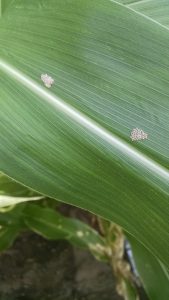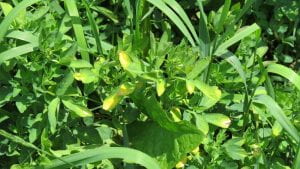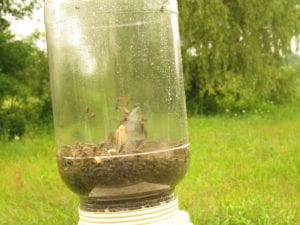Volume 18, Number 12
Contents
View from the Field
Western Bean Cutworm (Richia albicosta)
We have a western bean cutworm moth pheromone-trapping network that monitors this pest across the state. There are a total of 80 across the state. Data is starting to trickle in. By next week, we will have a good picture on the flight of the moths. We did have two traps this week that caught a lot moths. They were both in Washington County and in total, they caught 212 moths. Consider scouting your pre-tassel corn for egg masses and small larvae. Western bean cutworm moths only lay eggs on corn just before it tassels.
Potato Leafhopper (Empoasca fabae)
There are continued reports of potato leafhopper over threshold in several fields across NY. For information on scouting/monitoring PLH in alfalfa, view the following video: IPM for potato leafhopper in alfalfa-Video
True Armyworm (Pseudaletia unipuncta)
There were more reports this week of True armyworm being found in cornfields across the state. Armyworm issues should end soon as the corn gets taller and armyworms pupate and will no longer feed.
Horse Pal Flytrap
We have a demonstration of different flytraps on dairies in Essex County and one of these traps is a Horse Pal Fly Trap. I took a video of the number of Tabanids (horse and deer flies) in the trap.
It seems like it is doing a good job on capturing these biting flies
Weather Outlook – July 18, 2019
Jessica Spaccio
NOAA Northeast Regional Climate Center, Cornell University
Last week temperatures ranged from near normal to 4 degrees above normal. Precipitation has ranged from a tenth of an inch to near 3 inches. Base 50 growing degree-days ranged from 100 to 180.
Heat & humidity increasing through the weekend with occasional showers and thunderstorms. Excessive heat on Friday & Saturday!
Today will be warm and humid with temperatures in the 80s. Showers and thunderstorms will be possible, especially for eastern NY. Overnight lows will be in the 60s and low 70s.
Friday temperatures will be in the upper 80s to mid-90s with heat indices around 96-108; scattered thunderstorms are possible. Overnight temperatures will be in low to mid-70s.
Saturday temperatures will be in the 90s with heat indices reaching 100-110; scattered thunderstorms are possible. Overnight temperatures will be in the low to mid-70s.
Sunday highs will be in the upper 80s and low 90s with scattered showers possible throughout the day. Overnight temperatures will be in the mid to upper 60s.
Monday temperatures will be in the 80s in the with a cold front bringing scattered showers and thunderstorms. Overnight temperatures will be in the 60s.
Tuesday highs will be in the mid to upper 70s with mostly dry conditions. Overnight temperatures will be in the mid to upper 50s.
Wednesday highs will be in the mid-70s to low 80s. Overnight temperatures will be in the 60s.
The seven-day precipitation amounts will range from ¼” to 1 ¼”.
The 8-14 day outlook (July 25-31) favors below-normal temperatures for all of the state and below-normal precipitation for most of the state.
National Weather Service watch/warnings map
Storing grain…Remember Pests!
Do you have plans to store your small grains harvest on the farm? If so CLEAN your storage bins before loading grain into the bins. Sanitation is the key to keeping insect pests out of your stored grains. The following is a step by step method for IPM in stored grain:
- Clean grain handing equipment (augers, combines, wagons, scoops, and trucks).
- Clean inside the grain bin (remember to clean under the false floor). Mice, moths, weevils and much more can survive under the false floor.
- Clean around the outside of the grain bin. Remove all weeds, spilled grain and debris 6 to 10 feet from around the grain bin. This will remove all habitats that can support a grain bin pest problem.
- Seal all cracks and crevices. Cracks are prime locations for insects to enter grain bins.
- Cover fans when they are not being used. Insects can enter the grain bin this way also.
- Use a registered sanitizing insecticide spray in and around the structure after cleaning.
- Never store new grain with old grain.
- Dry the grain bin before adding new grain. Insect pests need moisture to survive.
- Level the surface after filling the grain bin. Moisture accumulates in a grain peak. Microbial activity in the wet area will heat up and attract secondary insect pests.
- Do not fill grain bin all the way to the top. Leave a few feet for aeration.
- Aerate the grain to at least the ambient temperature. The hotter the grain gets the faster insect pests can develop. Stored grain insect pests development slows when the temperature falls below 500 F.
- Monitor grain for insect pests every 20 days from spring till fall and every 30 days in the winter.
- If you discover an infestation of insect pests you may consider an insecticide application. Select a NYS registered product for your stored grain. READ THE LABEL.
- Keep areas around grain bins mowed to limit rodent hiding places.
Common Insect Pest of Stored Grain
|
|
|
Need More Information?
Maintaining Quality in On-Farm Stored Grain: https://extension.tennessee.edu/publications/Documents/PB1724.pdf
Preventing stored-grain insect infestation
Stored Product Protection (KSU). 2012.
http://www.ksre.ksu.edu/bookstore/pubs/S156.pdf
Webinar: Stored Grain Integrated Pest Management in North Central US – See more at: http://igrow.org/agronomy/corn/webinar-stored-grain-integrated-pest-management-in-north-central-us/#sthash.ARyppYYR.dpuf
Field Educational Events
What’s the Buzz-Flies on Cattle
3 Field Meetings on Integrated Pest Management for Cattle
Fly pests can affect animal health, decrease milk production and weight gain, transmit disease-causing agents, reduce grazing time, annoy and irritate animals and more.
Who are the usual summertime pest species and what can you do about them?
From this field meeting, you will learn to correctly identify the most important fly pests affecting cattle in the northeast. You will also learn techniques to determine if fly populations are at numbers that can cause economic injury. Learn the options available for controlling fly pests affecting animals including the role of parasitoids, predators, dung beetles, use of effective fly catching traps, and what you should know about making insecticide use decisions. This meeting has both organic and conventional options for managing fly pests on cattle and other livestock.
Tuesday, July 23
1-2:30 pm
St Lawrence County Cornell Cooperative Extension
Dairy-Adon Farm
403 St Hwt 72 Potsdam
http://stlawrence.cce.cornell.edu/events
Tuesday, July 23
6:30 to 8:00pm
St Lawrence County Cornell Cooperative Extension
Beef-Cookland Farm
13 Regan Road, Potsdam
http://stlawrence.cce.cornell.edu/events
Wednesday, July 24
6:00 to 8:00 pm
Franklin County Cornell Cooperative Extension
Tucker’s Black Angus Ranch
299 Hazen Road, North Lawrence
http://franklin.cce.cornell.edu/events/2019/07/24/whats-the-buzz
Weed Resistance Management Demonstration and Plot Tour
http://events.cornell.edu/event/weed_resistance_management_demonstration_and_plot_tour
Tuesday, July 23, 2019 at 1:00pm to 3:00pm
Quinten Good’s Farm – Parking at J. Martin Auctions 1036 State Route 318 Waterloo, NY 13165
Come join us on July 23 in Seneca County at Quinten Good’s farm for a demonstration and walking tour of 16 different pre- and post-emergence treatments in soybean and 12 different treatments and combinations in corn.
Tall waterhemp and marestail are two weeds that are resistant to glyphosate and ALS herbicide modes of action in the WNY and Finger Lakes regions.
Each year the number of acres with resistant weed populations expands.
For herbicides to be an effective tool in weed management, we have to know what chemistries & application timings are most effective against these resistant weeds.
Agenda:
1:00 – 1:15 Update on Current Status of Waterhemp and Marestail in NY, Mike Stanyard, CCE/NWNY Team
1:15 – 1:30 Waterhemp Resistance: Results of Spray Chamber Mode of Action Study , Bryan Brown, NYS IPM Program
1:30 – 2:15 Walking Tour and Review of Soybean Herbicide Treatments Jose Venancio Fernandez, Bayer Crop Science
2:15 – 3:00 Walking Tour and Review of Corn Herbicide Treatments Mike Hunter, CCE/NNY Team
Interseeded Cover Crops in Corn Field Day
Wednesday, July 24, 2019, 10-11:15 a.m.
Held at Conway Farms, 3999 East Road, Turin, NY 13473
This event is free and open to the public
1 NYS DEC pesticide applicator credit (Categories 1A, 10, 21) and CCA CEU’s will be available.
Dr. Bryan Brown, NYS IPM Program, Jose Venancio Fernandez, Bayer Crop Science and Mike Hunter, Cornell Cooperative Extension will discuss herbicide interactions with interseeded cover crops used in field crop production. They will also share up to date information on on the status of herbicide-resistant weeds in New York and talk about effective herbicide programs for corn weed control. This field day will provide attendees an opportunity to see several different herbicide programs used in the cornfield.
Roundup-resistant weed control field event
July 24, 2019
Van Hatten Farm, 7810 Putnam Road, Barneveld, NY
1 to 2:30pm
DEC and CCA credits available
Please preregister by calling Linda at 315-736-3394 x 124
Bryan Brown Cornell NYSIPM will discuss greenhouse herbicide screening results of waterhemp and herbicide resistance management study which includes cultivation, interseeding and select herbicides in both corn and soybeans. Bryan and Venancio (Bayer) will discuss the results of the herbicide trials conducted at 3 sites with special emphasis of the results of the trial at the Flowing Springs Farm evaluating the performance of select herbicides, pre and post-emergence timing, single and sequential herbicide applications on herbicide resistant waterhemp in soybeans . Participants can view plots.
Clipboard Checklist
Keith Waldron, NYS IPM
General
*Walk fields to check general field condition, weed, vertebrate and other issues
*Watch for crop maturity, stand assessments, weed escapes, nutrient deficiencies, lodging issues
Alfalfa:
*Evaluate established legume stands for approximate days until harvest
*Monitor potato leafhopper, foliar, systemic and crown rot diseases.
*Monitor new seedings for potato leafhopper, pythium blight, phytopthora root rot.
Small Grains:
*Monitor grain fields for growth stage, disease and lodging issues, grain maturity, harvest timing
*Record diseases present, location and types of weed escapes
Corn:
*Monitor for mid-season corn pests including European corn borer, corn rootworm, western bean cutworm, slugs, foliar diseases such as northern corn leaf blight and gray leaf spot, weed issues, nutrient deficiencies, vertebrate damage.
Soybeans:
*Monitor for soybean aphid, defoliators, foliar diseases, white mold, weed issues, vertebrate damage
Pastures:
*Check water sources, mend fences as needed.
*Check crop growth, clip pastures between grazing as needed
*Monitor for invasive species, plants harmful to livestock
*Review/Plan rotations
Storage:
* Check stored grain bins for temperature, moisture and signs of mold and insects. Aerate, core, transfer grain or treat as necessary
* Clean and disinfect empty storage bins in preparation for grain harvest
*Check forage allocation and anticipate feed program adjustments as forages from previous year are used up
*Mow around storage bins and facility to minimize pest hiding places
Dairy Cattle Barn Fly Management:
*Monitor animals and barn area for house fly, stable fly and other pest management needs including presence of rodents and birds.
*Check facilities for favorable fly breeding conditions: (organic matter + moisture): leaks in watering systems, roof gutters for leaks and potential overspill, drainage,
*Sanitation, sanitation, sanitation – clean animal resting areas, feed troughs, minimize source of moist organic matter i.e. fly breeding areas in barn and in adjacent animal loafing yard
* Continue fly monitoring: install “3X5″ index card fly speck monitoring cards throughout barn
*Use, replenish, replace fly management materials: sticky fly tapes/ribbons, insecticide baits, natural enemies (parasitoids), fly population monitoring (3 x 5) spot cards
*Consider purchase and release of Muscidifurax raptor and/or M. raptorellus natural enemies of house and stable fly pupae.
Dairy Cattle on Pasture:
*Monitor animals for presence of face flies, horn flies and stable flies. Action guidelines: face flies (average 10 per animal face), horn flies (average 50 / dairy per animal side, 200 / beef cattle per animal side), stable flies average 10 per animal (all four legs)
*Check feed bunk / water source locations for signs of stable fly breeding (moist undisturbed organic matter – spilled feed, round bales, etc.), minimize source of moist organic matter i.e. fly breeding areas in barn and in adjacent animal exercise yard.
*Check pasture for forage quality / quantity, rotate as appropriate
*Check pasture for vegetation poisonous to livestock
*Consider use of pasture fly traps to help reduce deer, horse and stable fly populations




